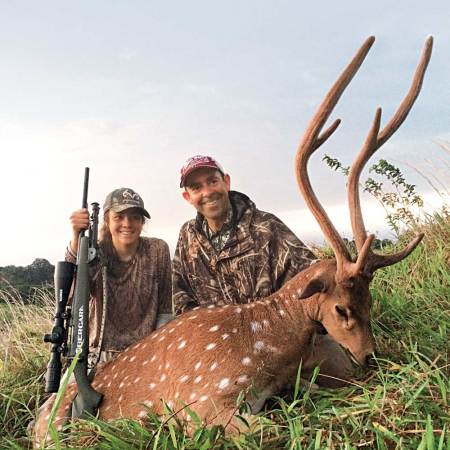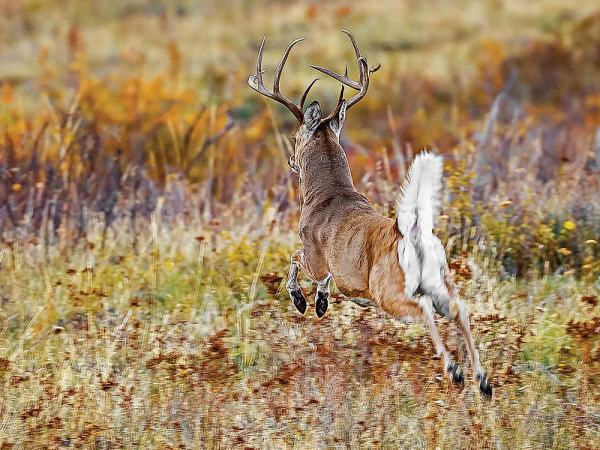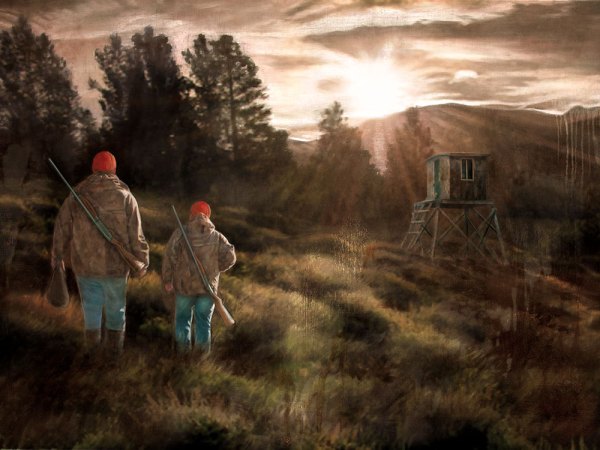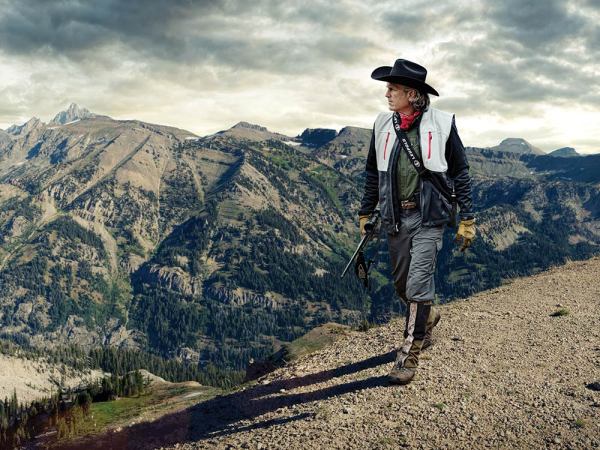“It’s time to go.” My father’s rough hand shakes my shoulder in the dark, but he speaks softly so my younger brother on the bunk above me won’t stir. Dad doesn’t know that I’ve been awake for an hour, listening to him sharpen his knife at the kitchen table.
I’ve been waiting in the dark of my bedroom for permission to join him, to shrug on his oversize denim jacket and follow him out the door into opening morning of Missouri’s deer season.
In my memory it’s always opening morning. I am 8 and shivering in wet gloves and a flimsy vest. I am 10 and allowed to carry my dad’s extra cartridges. I am 12 and cradling my first deer rifle—my granddad’s .25/20 Winchester—as though it was as fragile as a Christmas ornament.
In my memory it’s always a frosty fall on this farm, where I learned to milk cows, fix a fence and hunt deer. In my memory, November smells of wood smoke and Bag Balm.
I’ve hung sheaves of these memories on the twisted hedge posts of this farm, from the limbs of shagbark hickories and on the frame porch of this old farmhouse, where my father died last August.
Until he died, sudden and final as a gavel crack, I assumed there was an endless supply of memories here. Future holidays with my folks. Another deer season with Dad. Opportunities, maybe, to give my own sons the gift of opening mornings in these hardwood draws and hidden hayfields.
Earlier in the summer, Dad asked if I was coming home for deer season. “Sure,” I told him. “I’ll be there.” Now, with November here and time tight—and the farmhouse empty as an old boot—it would be easy to stay away, to sort my scattered memories of the farm into ordered nostalgia.

But among the items of my father’s I inherited was the first modern rifle he ever owned—an Interarms 7x57mm, made in Eastern Bloc Yugoslavia, with a sticky Mauser 98 action and a stock the color of dried mustard. I recalled his excitement when he got it in the late 1970s, new in the box, and all the evenings in the basement he spent working up handloads for the rifle.
I resolved to return to the farm in November, and I’d bring Dad’s Mauser for its last deer hunt on the home place. It would be a bit like hunting with my father, and it would be good company for what would likely be my final hunt here. That’s because, soon after my dad’s death, the wheels of change began to turn, and the family decided to sell the farm.
I suppose I could have remained in Missouri, coaxing life and an income from these rolling hills. But I inherited from my parents not an earthbound farm, but an urge to move, to look over the next hill.

Return to Missouri
It’s a long drive from Montana to Missouri, and to share both the driving and the hunting, I asked my buddy Mark Copenhaver to come along. It was somewhere in North Dakota that he asked the question every mule deer hunter eventually asks about whitetails: “How do you guys hunt back there?”
Mark wondered if we’d be sitting in tree stands or ground blinds, staking out a food plot or deep-timber trails. I laughed. That’s because my dad never had a hunting style or strategy. He just made up our morning’s plans as we walked out on the porch and assessed the weather. And among the things he gave me—ingrown toenails, a love of old maps, a tendency to tear up at the end of a sad song—is this habit of freelancing my hunting plans on the spot and in the moment.
When I started accompanying him, he’d perch me on a hay bale on the edge of a field or tuck me in the corner of a fencerow that separated two pastures. Then he’d walk away and leave me to make my own choices and to indulge fantasies that I was an Old West lawman or a North Woods trapper or a bounty hunter, almost anything except a skinny Missouri farm boy who was afraid of screwing up if a deer ever materialized. None ever did.
I learned to be a ground hunter, to stalk and post. I was a decade off the farm before I ever climbed a tree stand. But for a workaday farmer, my dad was a pretty good hunter. And he was a hell of a shot.
I still marvel at one especially remarkable shot he made. It was all of 400 yards, the deer running nearly wide open across a freshly chiseled soybean field. A single, arcing shot tumbled the buck, and my dad’s face, a combination of surprise and confidence, glows in the photo of him with the deer—a high, wide 5×5 with bases the size of a beer can. I still measure all whitetails by that rack, which Dad admired for a day, then tossed on the top rail of our corral until it fell into the weeds and was returned to the earth.
I take Mark to the corral, but all we find of that old buck is a rodent-gnawed skullcap and the stub of an antler. We could search longer but we both know there’s nothing left, and we’re itching to hunt.
The East Field
My first-day ritual when I return to the farm is to hike its perimeter. I check fences and creek watergaps, noting the same deer trails and bedding spots I learned more than three decades ago, but also noticing new poachers’ alleys. I escorted three parties off the farm the last time I hunted here. In my dad’s last years, he didn’t roam the farm much, and trespassers knew it.
It’s also my private tradition to end every hunt in our east field, a secluded patch of fertile bottomland hemmed by the creek on one side and the Milwaukee Road railroad tracks on the other. As a kid, this was the edge of the known world, with deep, dark timber to the south and east. And it’s where Dad always said the big bucks lived. Only I never encountered one here, not in a generation of hunting the home place.
Still, Mark and I sneak into a corner of the field. The wind is right and I rattle a pair of old sheds, hoping to get a response from a rut-frazzled buck. When I glass the field, I spot a decent buck pushing a doe. But the deer are at the far end of the field and it’s hard to judge antlers in the grainy light.
Then another buck stands up out of the uncut soybeans. He’s huge, and somehow his antlers glow like the tallow tapers of a medieval candelabra. I lower my binocular and tell Mark as matter of factly as I can, “I’m going to walk down there and kill that deer.”
Of course, it isn’t so simple. More than a thousand yards of soybean field stretch between me and this storybook buck. The first four hundred are easy. I cross under the train tracks, then use the railroad grade to hide my advance. In order to return to the deer’s side of the tracks, I have to wade a pool of brackish water under a low trestle. There’s no way around it. I remove my boots and socks, hike my pant legs up to my knees and slog through the frigid water, feeling for sharp locust thorns with my tender bare feet.
Now I’m hidden by a screen of oak trees, including the one where I notched my first archery kill 30 years earlier, a sassy fox squirrel I impaled to the tree’s trunk. I had to unscrew my broadhead in order to retrieve my arrow. As I pass it, I wonder momentarily if that head is still inside the strapping trunk. I glass the buck again. He’s still there, still tending his doe, but now his proportions rattle me. He’s tall and heavy, with junk on his right side.
I get so unhinged that I need to brace my binocular in the crotch of the tree to keep the image still. I’m using Zeiss’s rangefinding bino, and I hit the ranging button: 614 yards. The only way to get closer will be a tree-to-tree crawl through this fieldside stringer of timber. I sneak back to Mark and ask him for his bipod. I’ll need it for what promises to be a long shot with Dad’s 7mm.
Mark stays put, and I slink through the trees, reminded every few yards of my intimacy with this place. Here’s where my entire family used to walk the soybeans on sticky summer mornings, pulling by hand the cockleburs missed by our ancient cultivator. Here are the tracks where I’d leave pennies and washers—and once, my brother’s favorite Matchbox car—to be flattened by the grain train. Here’s where the 10 boys in my class stayed up all night following our 8th grade graduation, enraptured by a railroad tie bonfire we built in the freshly planted field.
Here’s where I’d park the hoist truck—yellow corn pouring into it like honey as my dad emptied the combine hopper—that I’d drive up the hill to the grain bins.
But now I am about to run out of sheltering trees, and the buck is still more than a quarter-mile away, still tending that doe, as the morning draws toward noon.
The only way to get closer will be to crawl into the field, a soggy matted mess of molding soybeans. This crop is unharvested because an August flood swamped them. My dad always kept a close eye on this creek, especially after back-to-back 100-year floods wiped out two consecutive crops in the 1980s, the decade of reckoning around here, when small farmers with debt sold out or took jobs in town in order to keep their land.
It seemed somehow fitting back in August, the week after my dad died, that the skies would open and the creek would rise and then flood, in a solemn, dreary tribute to him. Now, the flood’s aftermath would give me cover to make a final, soggy stalk to the buck.
I tuck my binos in my vest and drop to my knees, then my belly, liquid black gumbo washing into my bibs. Within 10 yards I am soaked but I continue my snake crawl, three rows at a time, aiming for a slight rise in the field that might give me just enough elevation to sail a 140-grain bullet over the weeds and taller beans.
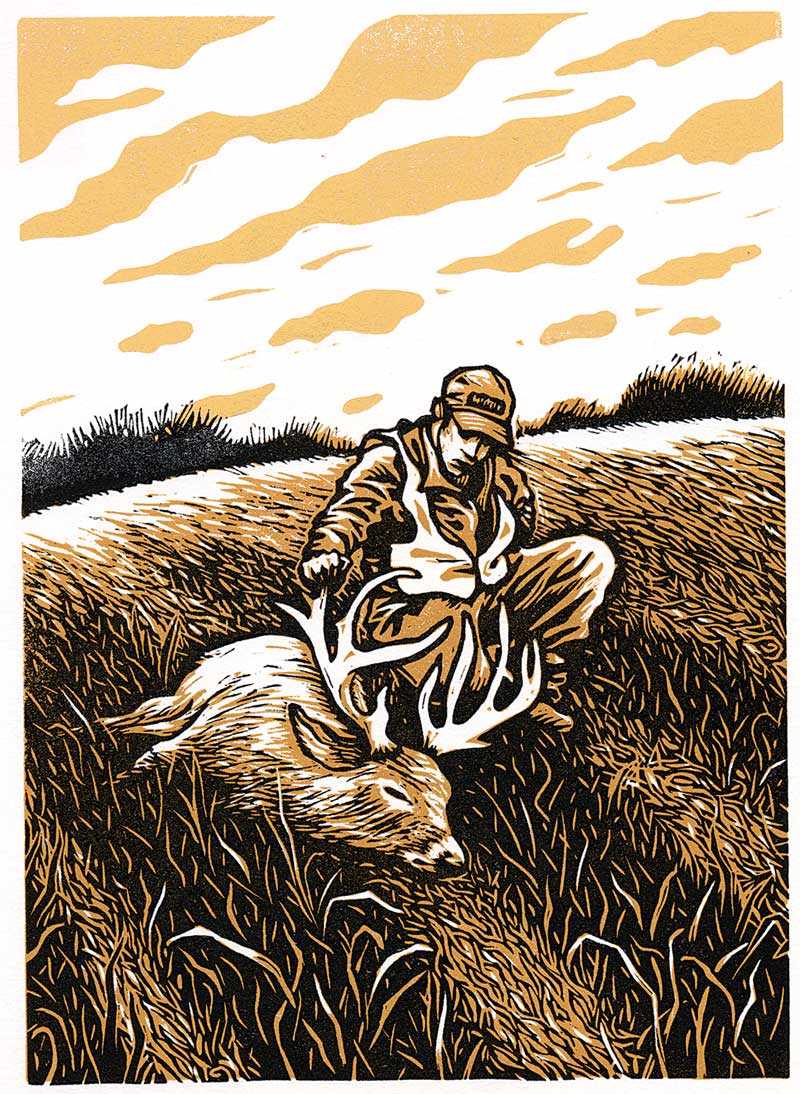
A Final Gift
I glass again. The buck is bedded in a corner of the field, still 350 yards away. But as I mark the distance, I see the buck bolt out of its bed, tail up, and mill nervously with a doe and younger buck. Have I spooked them? No time to find out. The deer are on the move, scrambling, anxious, unsure which way to run.
But either fate or fortune is on my side. The creek, the third man in today’s hunt, is swollen, so the deer can’t run east. Instead, they flare toward me, and I watch through my dad’s old fixed 4-power scope as the buck gets closer and closer.
When it’s over, I lay my father’s old Mauser on the buck’s flank, hold this remarkable head in my hand and sob longer and harder than I did at Dad’s funeral just up the road.
I’m tempted to throw the rack over the corral fence, but I’ll take it back to Montana and hang it on the wall to remember these 450 acres of north Missouri that will always be home, no matter where I live.
If you believe that land is something you can’t possess, but only borrow for a while, then it’s comforting to think of another family living here, another boy awakening to the wild world in these shady woods and rolling pastures. I still feel possessive of this farm, and want to guard its secrets and memories, but this deer is a final gift of the place. And I need to return to Montana, where my father’s grandchildren are making their own memories.
I drive out the lane for what might be the last time, the crunch of gravel under the pickup’s wheels.
I stop at the blacktop and look back at the farmhouse and the time-slumped barns strung along the ridge. And I hear my dad’s voice once again in my head. “It’s time to go.”
This story ran in the November 2010 print issue. For more of the story, and to see the photos of the hunt, see The Homecoming Buck







